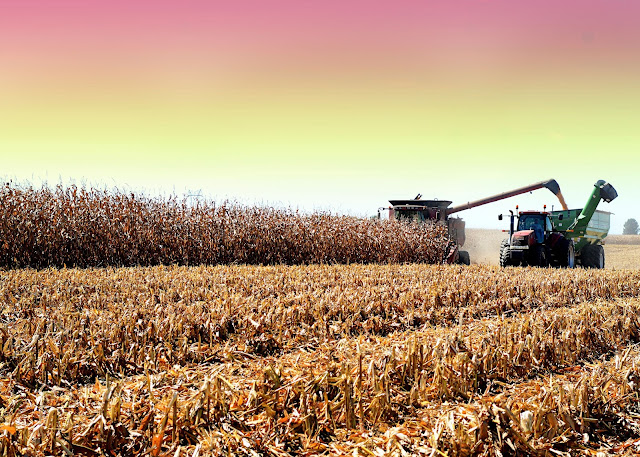This is definitely a question that I've heard before. Growing up on a farm, I guess I never gave it much thought. How long does it take to plant and harvest your crops?
There really isn't a definite answer to this question. While I can say how long it typically lasts on our farm, it depends on location and how many acres one farms. Planting usually starts the end of April/beginning of May here in southeastern Indiana. Several things are taken in to factor when deciding when is the right time to begin planting. I devoted a whole post to this topic actually, so if you are really interested in learning be sure to check it out here:).
Planting for us typically lasts 2-3 weeks depending on good ole Mother Nature. Sometimes it takes longer. Of course there is a lot of "prep" work that goes into planting too, like spraying the ground to help control weeds early. We call this spraying burndown. Also, we apply Anhydrous Ammonia to our fields that will be planted to corn. We do this before the field is planted. Some farmers do it after the corn is planted. This is called side dressing.
Below, Brad is applying Anhydrous Ammonia to a field that will later be planted to corn. This picture was taken mid-April of this year.
Harvest for us typically lasts A LOT longer. Notice how I capitalized the A LOT part? At least we hope it lasts long because that means yields are good....hopefully. 2012 didn't last very long, but it seemed like it lasted way too long. That was the year of the drought and yields hit an all time low, but we don't like to talk about that!
Harvest for us will last about 5-7 weeks, again, depending on Mother Nature and everything working like it is supposed to. All the grain that comes off the farm has to be hauled either to our farm for storage, or to a grain elevator to be sold. All of this takes time that's why it is important to be efficient on the farm.
The grain cart, or auger cart as some people call it, in the picture above will be pulled along side the combine for the combine to unload the corn on to, so the combine only has to make minimal stops. If the combine had to stop at the end of each round to dump on a wagon or semi, a lot of time is lost.
We started harvesting on September 20th. Our goal...or my goal rather:)...is to be done by Halloween, so we will see. In past years it has started much later and we don't finish until around Thanksgiving.
Planting seems to go by fairly quick, but sometimes harvest seems to drag on forever...I'm saying this from a farmwives perspective.:)




There really isn't a definite answer to this question. While I can say how long it typically lasts on our farm, it depends on location and how many acres one farms. Planting usually starts the end of April/beginning of May here in southeastern Indiana. Several things are taken in to factor when deciding when is the right time to begin planting. I devoted a whole post to this topic actually, so if you are really interested in learning be sure to check it out here:).
Planting for us typically lasts 2-3 weeks depending on good ole Mother Nature. Sometimes it takes longer. Of course there is a lot of "prep" work that goes into planting too, like spraying the ground to help control weeds early. We call this spraying burndown. Also, we apply Anhydrous Ammonia to our fields that will be planted to corn. We do this before the field is planted. Some farmers do it after the corn is planted. This is called side dressing.
Below, Brad is applying Anhydrous Ammonia to a field that will later be planted to corn. This picture was taken mid-April of this year.
Harvest for us typically lasts A LOT longer. Notice how I capitalized the A LOT part? At least we hope it lasts long because that means yields are good....hopefully. 2012 didn't last very long, but it seemed like it lasted way too long. That was the year of the drought and yields hit an all time low, but we don't like to talk about that!
The grain cart, or auger cart as some people call it, in the picture above will be pulled along side the combine for the combine to unload the corn on to, so the combine only has to make minimal stops. If the combine had to stop at the end of each round to dump on a wagon or semi, a lot of time is lost.
We started harvesting on September 20th. Our goal...or my goal rather:)...is to be done by Halloween, so we will see. In past years it has started much later and we don't finish until around Thanksgiving.
Planting seems to go by fairly quick, but sometimes harvest seems to drag on forever...I'm saying this from a farmwives perspective.:)

Our meals around the kitchen table are usually replaced by meals in the fields. I am becoming a pro at tackling kids' activities and busy schedules by myself. It definitely takes a village to raise kids, and I'm thankful for my village of family and friends who are willing to help out. I've gotten used to asking for help. Something I thought I'd never be able to do! While this time of year can be a struggle, I'm thankful that the rest of the year allows my husband to attend a lot of their activities.
While sometimes it's hard, I couldn't imagine living or raising my kids anywhere else!

And when Harvest is over,....


















































